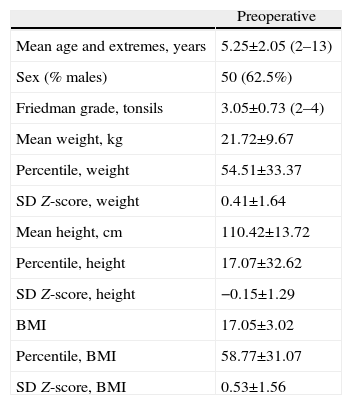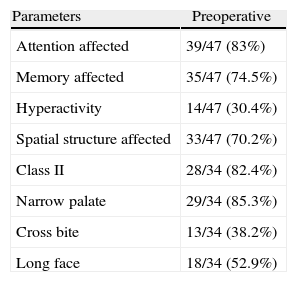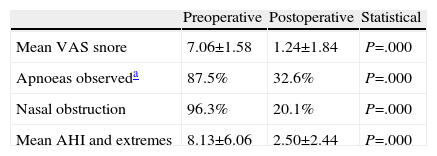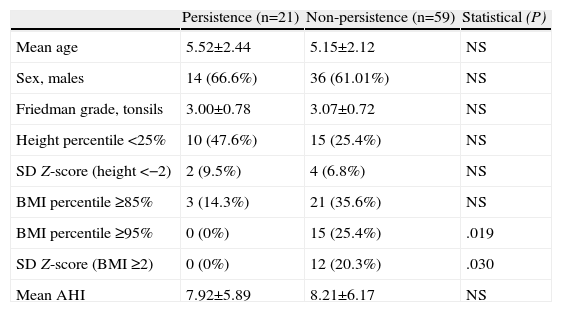Treatment of obstructive sleep apnoea–hypopnoea syndrome in children with adenotonsillectomy is effective but has a moderate rate of persistent disease.
ObjectivesTo analyse the rate of persistence of sleep apnoea–hypopnoea syndrome in a group of adenotonsillectomy-treated paediatric patients and to assess the possible prognostic factors.
MethodsProspective study of 80 patients aged between 2 and 13 years who had obstructive sleep apnoea–hypopnoea syndrome, treated with adenotonsillectomy. All patients had been followed up clinically and by polysomnography for 1 year after surgery. We analysed the epidemiological and clinical factors that could negatively affect the outcome of surgery.
ResultsThe median age was 5.25±2.05 years and the mean apnoea–hypopnoea index (AHI) was 8.13±6.06. One year after surgery, all clinical parameters improved significantly and the mean AHI was 2.50. Persistent disease (AHI ≥3) was present in 21 of the patients (26.3%). The comparative analysis of clinical and epidemiological factors between the group of non-persistence and persistence did not obtain statistically significant differences in age, sex, tonsillar size, Friedman degree, or severity of preoperative disease. The only significant factor was that patients without persistence were more obese.
ConclusionThe results of our study about the persistence of obstructive sleep apnoea–hypopnoea syndrome after adenotonsillectomy are significant enough to recommend follow-up with polysomnography, especially in high-risk groups. In the series presented here, we were not able to demonstrate these risk factors. Our results are probably conditioned by the characteristics of the population studied: low age, low obesity rate, and less severe levels of apnoea–hypopnoea index.
La adenoamigdalectomía (AA) para tratar el síndrome de apnea obstructiva del sueño (SAHOS) infantil es efectiva, pero presenta una moderada tasa de persistencia.
ObjetivoAnalizar la tasa de persistencia en un grupo de pacientes pediátricos tratados con AA y los posibles factores pronósticos.
MétodosEstudio prospectivo con 80 pacientes, entre dos y 13 años de edad, sometidos a AA por SAHOS. Seguidos clínica y polisomnográficamente a un año de la cirugía. Se analizan los factores epidemiológicos y clínicos que pudieran afectar negativamente el resultado de la cirugía.
ResultadosLa edad media fue de 5,25±2,05 años y el índice de apnea-hipopnea (IAH) medio de 8,13±6,06. Al año, todos los parámetros clínicos mejoraron significativamente y el IAH medio es 2,50. Presentaron persistencia de enfermedad (IAH ≥3), 21 casos (26,3%). Del análisis comparativo de los factores clínicos y epidemiológicos entre el grupo con y sin persistencia, no se obtuvieron diferencias significativas ni en edad y sexo, ni en talla y grado amigdalar de Friedman ni en la severidad de la enfermedad preoperatorios. Únicamente resultó significativo que los pacientes sin persistencia eran más obesos.
ConclusiónLas cifras de persistencia del SAHOS después de AA fueron significativas y aconsejaron seguimiento con polisomnografía, especialmente en los grupos de riesgo. En esta serie no se han podido demostrar estos factores de riesgo. Es probable que los resultados estén condicionados por el tipo de población del estudio: edad baja, bajo porcentaje de obesidad y niveles de IAH menos severos.









